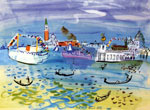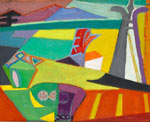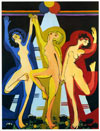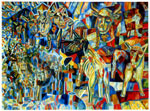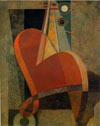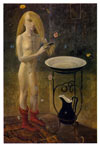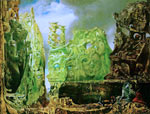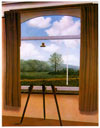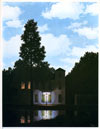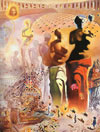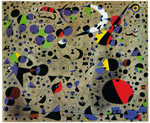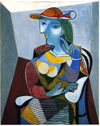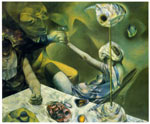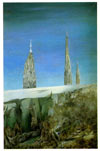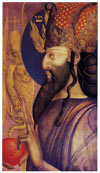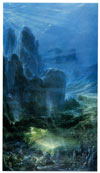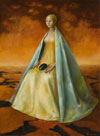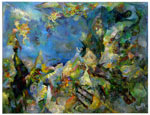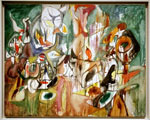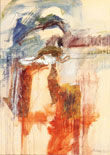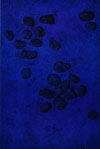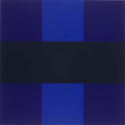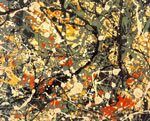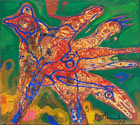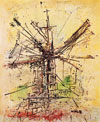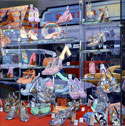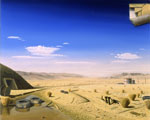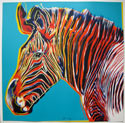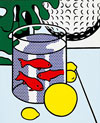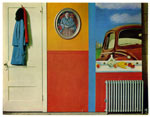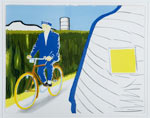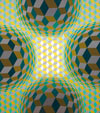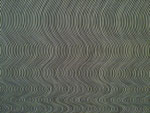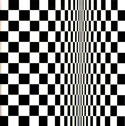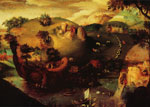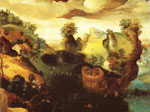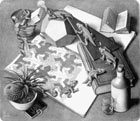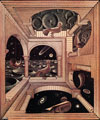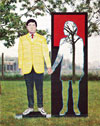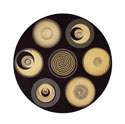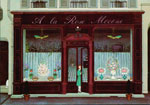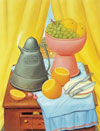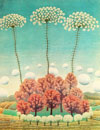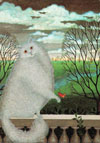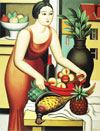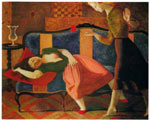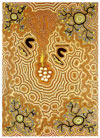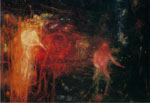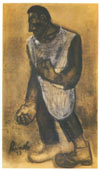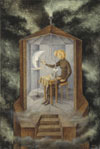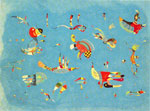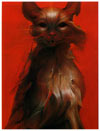
Moving Movements, History of Modern Painting, After 1930
PAINTING AFTER 1930
Kurt Gödel presented in 1930 de incompleteness proposition, one of the most important in mathematics. The electron microscope was invented in 1931 by Ernst August Friedrich Ruska, as well as Rheinhold Ruedenberg. In 1937 Alan Turing introduced the Turing machine, a theoretical model of a computer. In 1939 there were already commercial flights over the Atlantic Ocean. In 1940 Ultra made the first useful computer in the world, Robinson, i.a. to decode the German messages. In 1941 the German Konrad Zuse developed the first programmable digital computer, the Z-3.
click the thumbnails
Raoul Dufy
Venice 1938
André Lhote
Untitled, Landscape in Green and
Orange, undated
Ernst Ludwig Kirchner
Colour Dance II 1932-34
Pavel Filonov
Animals 1930
Karol Hiller (Polen)
Composition 214A 1935
Lyonel Feininger
Bird Clouds 1931
Boleslaw Cybis (Polen)
Primavera 1936
Max Ernst
The eye of silence 1944
Paul Delvaux
The Acropolis 1966
René Magritte
The Tiredness of the People 1934
René Magritte
The Dominion of Light 1954
Salvator Dali
The hallucinogenic Toreador 1968-70
Joan Miro
La poétesse 1940
Pablo Picasso
Portret of Marie-Thérèse Walter 1937
| Dali’s and Bunuel's second film "L'Age d'Or" was running in
1930.
A group of fascists demolished the theatre and destroyed several paintings. De Romanian surrealist Brauner came to Paris. Dominguez from Tenerife made very precise works, reminding Dali. Surrealistic sculptures in '33 came from Giacometti, Brignoni, Arp and Moore. In '35 the Austrian Wolfgang Paalen changed form abstract to surrealism. He worked i.a. with "fumage": smut of a candle on canvas. Later he will also paint wonderful fantasy landscapes. Delvaux, an expressionist, became surrealist, but never left Belgium. In '34 there came a rift between Dali and Breton. As it were because Dali had painted two times Hitler, but the real reason was Dali's commercial attitude and aristocratic features. Dali did go to America, where he got great success with his slack watches. Surrealism was introduced in the fashion there. Duchamps made his zijn rotoreliefs, which have to rotate to give an optic effect. Dominguez started in '36 his "decalcomania", in great contrast to for example his very figurative "Los Porrones" from '35; now coincidence plays the main part. Ernst will also use this technique, i.a. to overpaint it and to create in that way fantastic landscapes and figures. Decalcomania is a technique of mixing the paint for example with wallpaper paste, and press it on another page, alternatively rub it, or scratch it... The technique was already used by William Blake. (See the illustration underneath, the decalcomania has been used for the rock on the left.) |
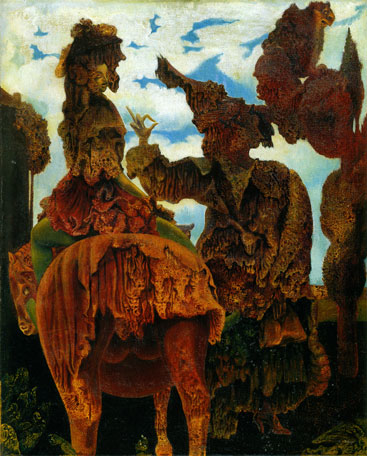 |
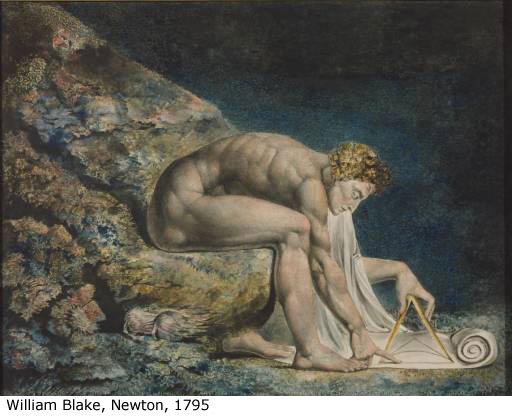 |
The number of surrealists was still increasing: Carrington, Mednikoff, Olson, Mörner. Dali painted his "Premonition for the Civil War", but he sympathised with Franco. Also in '36 was the first exhibition in Paris of surrealistic objects: strange combinations of existing objects, also litter, stones, shells, fossils (objects trouvées), fetishes, ready-made's... In '35 surrealists exposed in Japan and South-America. Matta, a Chilean, joined the surrealist movement in '37, meanwhile he had became the most abstract painter of the group. Tensions, lack of interest and moves caused the group to fall apart in '38. But it didn't surely mean the end of surrealism as movement, which goes on until today. |
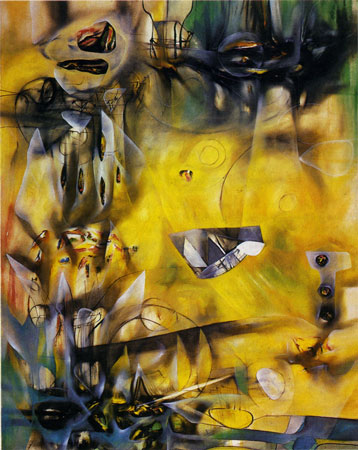 |
Made in America In the war of '40 - '45 a lot of surrealists fled to America, but they didn't want to have anything to do with Dali. Dali had returned to the catholic faith and painted large works in his "nuclear mysticism". Peggy Guggenheim moved to America, married Ernst and opened her "Art of this century Gallery", which became the headquarter of the surrealists: Breton, Ernst, Tanguy, Masson, Man Ray, Seligmann, Dali and Matta. Also non-surrealists took refuge in America: Chagall, Leger, Mondriaan, Lipchitz. American artists were very much influenced by the non-figurative surrealism: Pollock, Gorky, de Kooning, Kline. Ernst invented there his "oscillation" technique: hang a can with a little hole at the bottom at a cord, and let it oscillate above a canvas while the paint is running out of the can. Ernst used it as a source of inspiration, added hand painting of scratched it away to create new forms. But Pollock used his technique as a purpose on its own and so "Action painting" started, called the "first real American style", borrowed from Max Ernst. |
Also in America surrealism didn't stay together: Breton couldn't speak English,
Masson and Tanguy moved to somewhere else, Ernst divorced from
Peggy. The new surrealists in the years '40 were Colquhuin, Herold,
Toyen, Lam, Granell, Dorothea Tanning, Onslow-Ford, Seligmann, Cornell,
Tauning, Kamrowski and Gorki (abstract), Polloc, Pellan, Borduas, Serpan,
Morris, Sutherland in England, Nemes in Hungary, and so on... Until today this novelties of surrealism such as objects-trouvées, happenings, environnement... are still in fashion, and have their continuation in the concept art. |
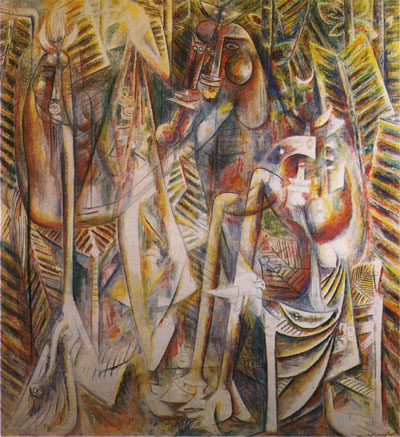 |
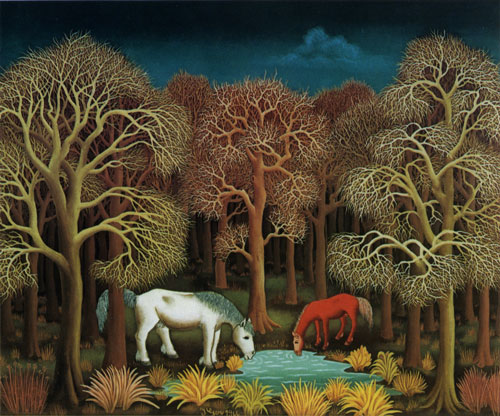 |
After 1950: a geyser of style directions Surrealism evolved in two different directions. The figurative surrealism gave birth to what was called "fantastic art", sometimes "neo-surrealism" and today also "visionary art", also other terms exist, as "magical realism" and "psychedelic art". The most well known in the years '60-'70 were Fuchs and Fini. The other and abstract branch evolved to kinetic art, optical art, concept art. Expressionism did continue via abstract surrealism and experimental techniques to the "abstract expressionism", with for Europe for instance the group Cobra. Also pop-art and hyperrealism arose. The American culture now dominated the European culture and decided what is real art and what is not. Now follows a survey of some of the most well known art directions after 1950. |
![]()
Figurative surrealism was not finished. Matta belonged to Breton's group and will life long and paint a lot. Also Eric Brauer had belonged to the group. Dorothea Tanning became the next wife of Max Ernst and painted surrealistic too. There were several others: Edgar Ende for example (father of the well known writer Michael) painted dream scenes, which is pure surrealism, not fantastic art or visionary. |
click the thumbs Roberto Matta |
Wolfgang Paalen |
|
| From figurative surrealism also evolved fantastic art and visionary art, as we said. The basic of figurative surrealism was combining things which normally do not belong together, in order to touch the unconsciousness. A fair example is Magritte, with for instance half a beer bottle, half a carrot. But for fantastic art everything was possible: it only had to come from the fantasy. Some painters of "fantastic art" and "visionary art" created a wonderful and magical mood, and therefore they are more close to the earlier symbolists then to the surrealists. |
Ernst Fuchs |
Roland Cat |
Jean Leonor Fini |
| The abstract painting flourished and gave us wonderful art sometimes full of life, others remain sober, even monochrome. Some choose for a severe geometric abstraction. |
Archile Gorky |
||
|
Ad Reinhardt, |
|||
| As we told, "abstract expressionism" evolved from abstract surrealism and German expressionism. Some of the late expressionists painted their canvas in the most short time, to keep the spontaneous, expressive, childlike. In abstract expressionism some works were made by special techniques. Other painters still used their brushes, but painted quickly and brief. Also Picasso and Miro evolved to this way of working. One of the most famous groups was the Cobra, an anagram of Copenhagen, Brussels and Amsterdam. The original members were Pierre Alechinsky, Asger John, Karel Appel, Corneille and Constant Nieuwenhuys. |
Pollock |
Jean-Paul Riopelle |
Constant Nieuwenhuys 1970 |
|
Pierre Alechinsky, |
Wols, |
Georges Mathieu, |
|
From realism evolved hyperrealism (also called photorealism). The reality was showed as precise as possible. Nevertheless the paintings do not really resemble photos, the hyperrealists claim the fact that, how precise one ever paint, the difference with the photograph is what makes it special and beautiful. It gives the canvas a special mood. Their subjects are contemporary and often rather banal: a street view, a gas station, a rusty wreck, litter... The style has now lost quite a lot of interest, maybe because of the fact those works are not enjoyable on small scale, as in books, on screen... It is necessary to go and see the original work to be able to experience the special mood. |
|||
Pop-art became very popular in the years '60, with scenes copied from cartoons, painted cans, Marilyn Monroe in diverse fierce colours...
|
Andy Warhol |
||
Others painted a kind of realism in the pop-art way. |
Roger Raveel |
||
| Optical art brings about optical effects, two- or three-dimensional. Most known are the optical effects of the paintings of the Hungarian Vasarely, whose real name is Vásárhelyi Guozo. Also Riley is a well known name. |
Bridget Riley, 1965 |
Bridget Riley, |
|
Others worked with optical illusions or the play with two or three dimensions. Optical illusion is favourite in painting already quite some time. Famous are the works of Archimboldo (see illustration op the page Japan, because it is very similar to an old Japanese painter). But there are less known artists, such as the two anonym works on the right, each one presenting a face as well as a landscape. If the work hangs horizontally, the emphasis is on the landscape. If hung vertically, the emphasis is on the face. Salvador Dali used this technique form time to time, the example on the right is one of the most succeeded. The graphic artist Escher liked to play with it. The work form Raveel is an example from pop-art, where an optic effect is used as well: the figure on the right is a contour which gives a view on the landscape behind. |
|||
|
Mauritz Escher |
Esher, |
Roger Raveel, |
|
Kinetic art adds to the three dimensions of sculptures a fourth on: movement. Marcel Duchamps gave the start in 1923 with his discs, which he did put on gramophone turning table. When the disc turns, it creates a strong view of depth. (The seven discs showed on the right have to be regarded turning one by one. The other two links are connected to YouTube, to let you see the movement.) |
|||
But there were totally different directions that flourished in Europe, as for example naive painting, which expressed itself in different styles. To give one well known example; in the years 1930 Generalic arose in Yugoslavia. First he did paint common people scenes and landscapes, as many other naive painters did, but also political and social events. In the years '40 his style became more poetical by means of more colour and light contrast, as for example with pale branches of winter trees, resembling leaf veins, on a dark background. His portraits show he is technical well-grounded, the naivety is on purpose. He paints in oil behind the glass. For this reason the order of working is reversed: one has to start with the foreground and to end with the background. The mood of his works is extremely poetical and reminds Rousseau or Chagall. In '59 he did make "The Marriage of the Stag": repetitive, white deers, resembling bulls, are standing in a row and create a surrealistic atmosphere, as does the fierce red "Unicorn" from '61 or "Two Peacocks" from '67. He had his own school and a lot of painters inspired them on his style or did search variants. |
Ivan Generalic |
Petar Grgec |
|
|
Fernando Botero,
|
FernaIvan Rabuzin, |
||
Realism never disappeared since it arose half away the 19th century. New artists came up, whom had enough from all movements and experiments, and did fell back on realism. They became more and more colourful. The really good ones had a personal and original style. |
Jean Metzinger, |
Claude Roy Balthus |
|
Some painters were inspired by their age-long culture, and developed a personal style based on the tradition. Here an example of a painting of an aboriginal from Australia. Copyright for the text of all pages of this History of Modern Painting: Johan Framhout; text written in 1990-92; revisionned and put on the internet in 2005; translation in English 2012 |
Jeanny Egan Nungarrayi |
||
|
Erik Brauer |
Constant Permeke |
Remedios Varo |
Octave Landuyt |

